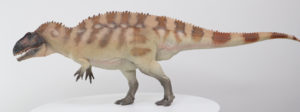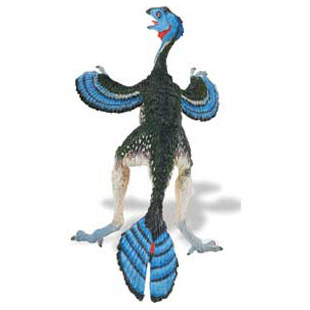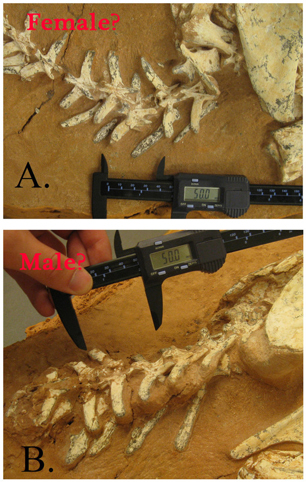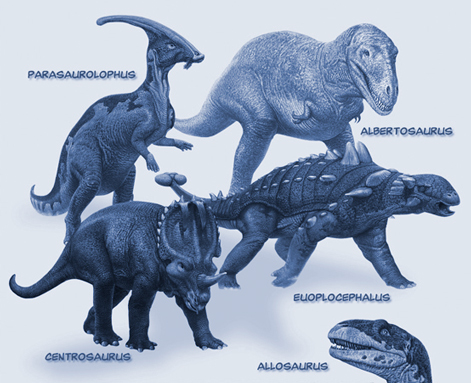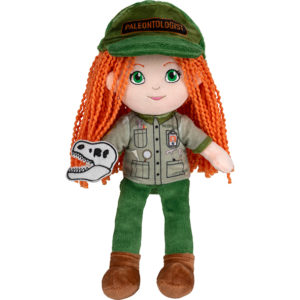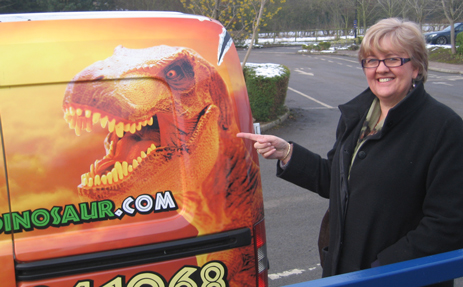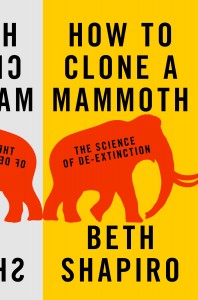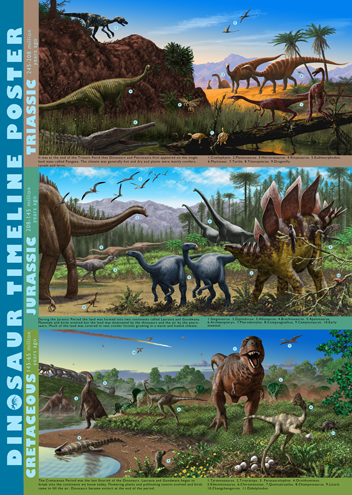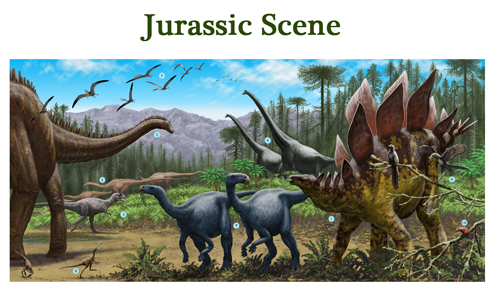Potential New Titanosaur Genus from Siberia – “Sibirosaurus”
Scientists at Tomsk State University (Russia) are busy compiling a technical paper and completing further studies that could affirm fossilised remains found in 2008 are those of a giant titanosaurid dinosaur, very probably a new genus as well. Although titanosaurids are known from most continents, even Antarctica, this, as far as we at Everything Dinosaur are aware, is the first case of a potential titanosauriform being scientifically described from Russia.
The animal lived in the Late Cretaceous, around 100 million years ago (later part of the Albian faunal stage) and its remains which include cervical vertebrae, a partial scapula (shoulder blade) and elements from the sacrum have been painstakingly extracted from sandstone, which much to the chagrin of the research team is from a band of rock that is as hard as concrete.
New Titanosaur Genus
The dinosaur’s bones were discovered in strata, that forms part of an eroded cliff on the banks of the Kiya River, close to the small village of Shestakovo in the Kemerovo region of southern Siberia, around ninety miles south-east of the city of Tomsk.
The Excavation Site – Kiya River Location
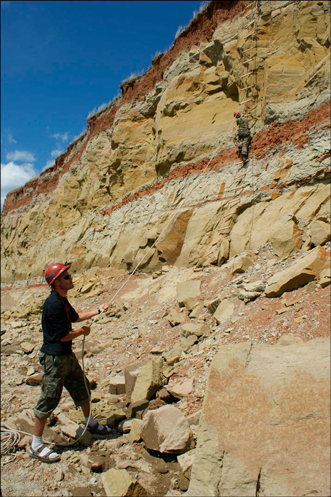
Palaeontologists need a head for heights.
Picture credit: Tomsk State University
Challenging Access to the Fossils
The fossil bearing strata is located half way up a ten-metre-high bank and it is only really accessible during the late spring and summer months. This part of Russia is subject to extremely cold temperatures and a lot of snowfall in the late autumn through to the spring. From the months of October through to March the average daytime temperature rarely rises above freezing. However, August temperatures can exceed thirty degrees Celsius. It is the changing temperatures (freeze/thaw) that lead to erosion of the banks exposing dinosaur fossils.
A Scientist Explores the Fossil Bearing Sediment
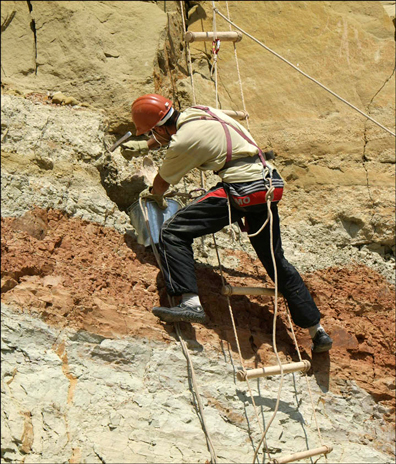
A scientist carefully works away at the rock face.
Picture credit: Tomsk State University
Discovered in 2008
The fossils were originally discovered back in 2008, they had been preserved inside sandstone concretions and although in some cases the fossils were compressed and they represent just a fraction of the skeleton, their location and size indicate that these fossils consist of the remains of a long-necked dinosaur that would be new to science.
The rocks around the village of Shestakovo have already yielded a number of dinosaur fossil specimens. Last year, Everything Dinosaur team members reported upon the naming of a new species of Psittacosaurus from fossils found in this locality by scientists working for the Kemerovo regional museum.
To read more about the new species of Psittacosaurus: Russian Scientists Name New Psittacosaurus Species.
Commenting on the research, Dr. Stepan Ivantsov (scientific researcher in the Laboratory of Mesozoic and Cenozoic Continental Ecosystems), stated:
“When we discovered this finding, it was only clear that the remains belonged to a very large, herbivorous dinosaur from the sauropod group. It was the first scientifically described dinosaur from this group in Russia. Now after work on the excavation of all the remnants and the restoration [of the bones] is almost completed, we can confidently say that we have found a new species and maybe even a new genus.”
A Dinosaur Amongst the Woolly Mammoths
This part of Russia is famous in palaeontological circles for the preserved remains of another large, prehistoric herbivore but one that is geologically hundreds of times younger than any Late Cretaceous dinosaur. Many fossils of Woolly Mammoths are found in this region, including shed teeth and intact tusks.
A Close up of Some of the Titanosaur Fossil Material
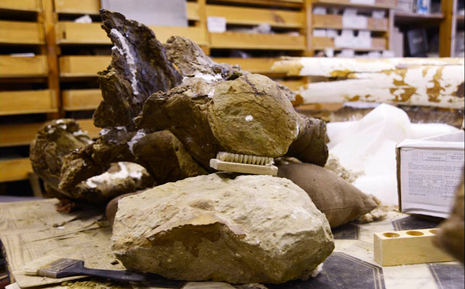
Some of the fragmentary fossils.
Picture credit: Tomsk State University
Preparing the Fossil Material
The fossils in the picture look like elements from the cervical vertebrae (neck bones). In the background on the right, the posterior end of a large Woolly Mammoth tusk can be seen. The scientists will continue their studies and a scientific paper on this new dinosaur should be published in the near future, as for where the fossils might end up, the researchers have expressed a wish that they should remain within the palaeontological collection of the University, but stress that they could be put on display for members of the public, as well as students to see.
As fossil material is being constantly eroded out rocks at this site, the scientists hope to find more fossils of titanosaurs. In 1995, bones believed to come from the foot of a titanosaur were also discovered in the same area. At this stage, the researchers cannot say for certain whether these foot bones are from the same animal whose fossils were found in 2008, they can’t even be sure whether or not the foot bones and the 2008 material come from the same genus. Still, it is very likely that more dinosaur fossils are awaiting discovery. The dinosaur has been nick-named Sibirosaurus (lizard from Siberia), but a more formal nomenclature is expected.
A Close Up View of One of the Fossil Specimens

A close-up of one of the fossilised bones.
Picture credit: Tomsk State University
Letting Erosion to Take Its Course
The picture above shows a close up of one of the fossil remains. Although, it is difficult to make out for certain, this fossil might represent a fragment from the sacrum (fused sacral vertebrae). The sandstone rock is extremely hard and this limits the amount of fossil material that can be removed. Use of explosives to bring down large portions of the bank have been ruled out as the force from such an explosion would very likely damage any adjacent fossil material. For the scientists, it is simply a question of allowing natural erosion to do its work, aided and abetted by careful manual excavation whilst hanging onto a rope ladder which dangles several metres down the near vertical bank.
Everything Dinosaur stocks a wide-range of titanosaur replicas and models. To view the models section of Everything Dinosaur’s award-winning website: Dinosaur and Prehistoric Animal Models.
A spokesperson from Everything Dinosaur commented:
“It is very likely that more dinosaur fossil remains will come from the Shestakovo locality, however, they are likely to remain highly fragmentary making species level identification very difficult. However, this fossil material adds to our understanding about the globally distributed titanosaurs, some of which were the largest terrestrial animals known to science.”
Everything Dinosaur acknowledges the role of the Siberian Times in the compilation of this article.
